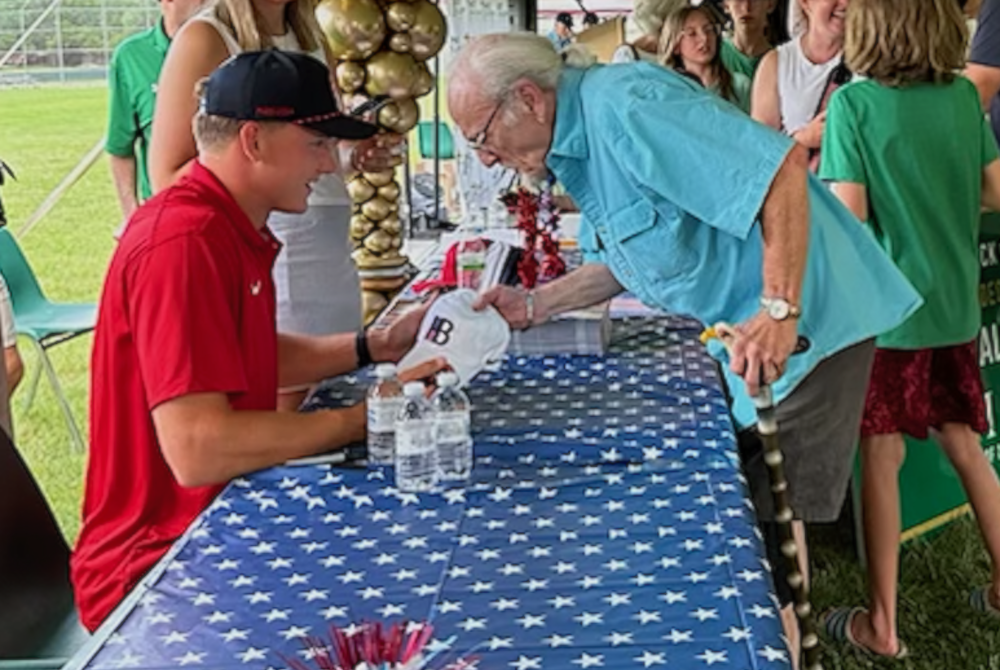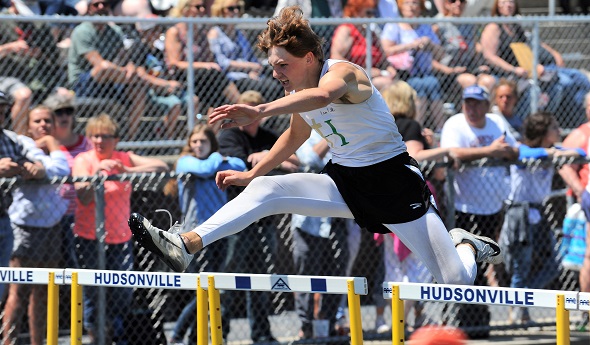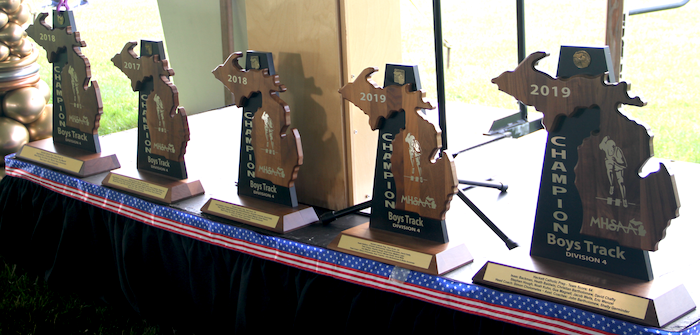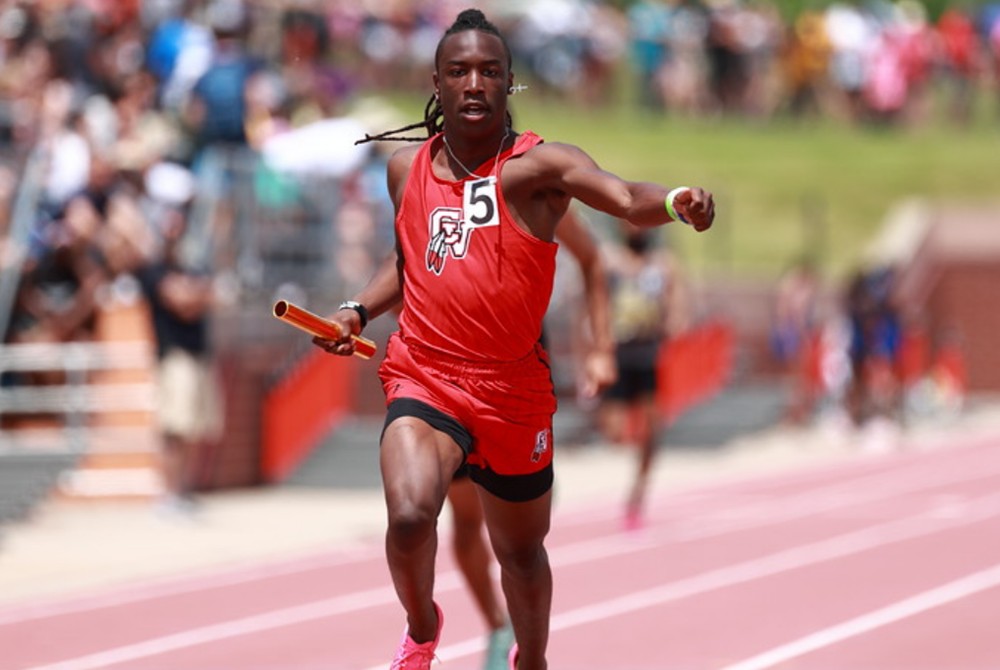
Hackett Catholic Prep's Baldwin Carrying Hopes from Home to Paris
By
Pam Shebest
Special for MHSAA.com
July 12, 2024
KALAMAZOO — Heath Baldwin studied Spanish at Hackett Catholic Prep, but he will need to brush up on some French as he heads to Paris to compete in the 2024 Summer Olympics.
The recent Michigan State University grad, who earned a master’s degree in marketing and research analytics, will compete in the decathlon, a two-day event Aug. 2-3 at the Stade de France.
While the Olympics will be televised in the United States, because of the time difference, Baldwin’s events will take place locally during the early morning hours.
Wishing him a Bon Voyage, more than 200 former classmates, friends, family and well-wishers plus six television crews congregated Thursday for an impressive sendoff, starting with the Hackett “Summer Ensemble” playing the school fight song.
A 2019 Hackett grad, Baldwin led the track & field team to three Regional championships, two MHSAA Lower Peninsula Division 4 titles, was an individual five-time Finals champion, holds four school records and was named track & field Athlete of the Year for all divisions his senior season by the Michigan Interscholastic Track Coaches Association.
“I went through a lot at Hackett, obviously, with my dad (Roger) passing away (in 2016) and I always had a great support system of people who took care of my family and made sure we were doing good,” Baldwin said. “They’ve stuck with me through college, too, following me in all my events and to this point, so it’s cool that I’m doing well now and they’re along for the ride.”
 The ride will begin Tuesday when Baldwin travels to Germany to train before heading to Paris.
The ride will begin Tuesday when Baldwin travels to Germany to train before heading to Paris.
“Everything’s starting to feel more real,” he said. “I think once I get to Germany and start to train with other people, we’ll be able to get a little competitive. I think it will be fun training in Paris.”
Facing a huge crowd in Paris should not be a problem, he said.
“The more people will only help me. I’m a big adrenalin guy. I feel like I get more nervous talking at an event like this than I do for the Olympic Games.
“Once I get out on the track, everything just feels natural to me.”
Naturally a no-brainer
Baldwin’s Finals championships for Hackett had come in high jump, long jump and both hurdles races. Tackling the grueling decathlon was a no-brainer.
“I was good at the hurdles, high jump, long jump, which are three very technical events in the decathlon, so if you’re good at those three, you usually can pick up the other ones pretty easily is what they say,” he said.
“Also, I played baseball as a pitcher, so that correlated with the javelin. A lot of college coaches recruited me off that, I think.”
Baldwin said knew 2024 was an Olympic year, “so I thought it was something I maybe could do. After last year, when I scored above 8,000 points (in the decathlon) for the first time and came in sixth at the USAs, it became a little more realistic for me.”
The personable athlete not only qualified for the Olympics at this year’s U.S. Track & Field Trials in Eugene, Ore., but won the decathlon with a personal best 8,625 points.
He finished first in the shot put (54 feet, 2½ inches), high jump (6-11¾), 110 hurdles (13.77 seconds) and javelin throw (218-9).
 Other decathlon events are the 100 dash, long jump, 400 run, discus, pole vault and 1,500 run.
Other decathlon events are the 100 dash, long jump, 400 run, discus, pole vault and 1,500 run.
Baldwin earned Great Lakes Region Indoor and Outdoor Field Athlete of the Year honors and was named first team Academic All-American with a 3.8 GPA.
"We were awestruck at his athletic achievements (at Hackett),” said Judge Paul Bridenstine, the “Voice of the Irish.”
“While he continued to play football, basketball, baseball exceptionally at Hackett, his athletic life was transformed when he was introduced to (former HCP track & field coach Simon Cholometes).”
Cholometes said Baldwin’s success is something that didn’t come out of nowhere.
“Heath put the wheels in motion a long time ago and worked harder than most people can even fathom,” he said. “I can remember 5:40 in the morning, Heath running sprints up that hill over there,” he said, pointing. “A foot of snow, running sprints up that tall hill.
“In college, he’s a Big 10 champ, three-time All-American, Great Lakes Region Indoor and Outdoor Field Athlete of the Year, MSU’s Athlete of the Year twice, holds five school records plus Big 10 records in heptathlon and decathlon.”
Family won't be far
Baldwin plans to be in Paris for the opening ceremonies and will be cheered on by his mom Suzann, sister Hope and brothers Aiden and Gowan.
The Olympian also will have a remembrance of his late father with him. He has a tattoo of his dad’s signature on the inside of his upper left arm.
 Losing his father “was a big part of my life and obviously changed my perspective in the way I train and the way I live in a way he’d be proud of,” Baldwin said.
Losing his father “was a big part of my life and obviously changed my perspective in the way I train and the way I live in a way he’d be proud of,” Baldwin said.
“We set some big goals going into this year and it’s been a dream. I love representing the Kalamazoo community and Michigan, Hackett and Michigan State.
“I like to remember everybody I compete for, and I think that gives you a bigger purpose when you go out there. That’s definitely something I’ll be doing at the Olympics in Paris. I’m excited to represent there and hopefully go for a medal.”
PHOTOS (Top) Health Baldwin, seated, signs a hat during his sendoff Thursday at Kalamazoo Hackett Catholic Prep. (2) Baldwin clears a hurdle during the 2019 MHSAA Finals. (3) A hurdle was gifted to Baldwin on Thursday. (4) MHSAA trophies Baldwin helped win decorated the stage for his sendoff. (Sendoff photo by Pam Shebest.)

Chippewa Valley's Heard Has Big Plans to Add to All-Time Sprint Legacy
By
Keith Dunlap
Special for MHSAA.com
May 10, 2024
CLINTON TOWNSHIP — Clinton Township Chippewa Valley senior Shamar Heard admits he’s thought about it, and for good reason.
 After all, why not at least entertain the thought of doing something unprecedented in state history when it comes to track & field?
After all, why not at least entertain the thought of doing something unprecedented in state history when it comes to track & field?
Two years ago as a sophomore, Heard achieved the double in the fastest races, winning both the 100 and 200-meter dashes at the Lower Peninsula Division 1 Finals.
Last year, Heard completed the trifecta when it came to sprint state titles, focusing solely on the 400 dash and winning that event in 47.78 seconds while also running on first and third-place relays.
So, how about trying to train for and win all three events this year as a senior? Who in the state would be able to stop him?
“I definitely have been thinking about it,” Heard said. “Because why not? It probably hasn’t been done in a long time, if ever.”
But while the thought has crossed his mind, it won’t happen. It’s a little much on the body — in particular running the 100-meter dash — to try and do all three at once.
However, Heard in the coming weeks is still in a good position to cement what already is a place among the greatest sprinters to come through the state of Michigan.
First, he has big things in mind for his specialty race, the 400 meters. He has won two consecutive AAU national titles in that event in addition to the Finals title he won last year, but is craving more.
“I want to be at 45 seconds for the state meet,” Heard said noting the June 1 Finals at East Kentwood.
In addition, Heard plans on competing in the 200 meters at East Kentwood. He also is a part of Chippewa Valley’s 800 relay team that won last year in 1:26.41. He’s expected to qualify for all three at the Regional on May 17 at Romeo.
 When Heard is done with high school, he will continue running track at Tennessee.
When Heard is done with high school, he will continue running track at Tennessee.
It’s all mighty impressive for a speedster that Chippewa Valley head coach Terry Wilson said hates lifting weights and is “barely above 150 pounds.”
“He doesn’t weigh a whole lot, but he generates a lot of power,” Wilson said. “His strength-to-weight ratio has to be astronomical. He’s just gotten better with his form.”
Throughout his entire life, Heard said he’s simply loved racing. When he was a kid, he would constantly pick out a stop sign on a street or another spot in a yard and race others to the finish, often beating them with ease.
When he was 10 years old, he was invited by a friend to come out for a track team, and he proceeded to beat others in races continuously.
As he got a little older, Heard discovered how gifted he was running the 400 meters and started to focus more on that event.
Heard said he loves the 400 meters so much mostly because he loves embracing a challenge many sprinters don’t want to face.
“I like that not many people want to go through that pain,” he said. “I take it as a compliment when people look at (the 400) and they say, ‘Hey, people are crazy for doing that.’ That makes me motivated to do it.”
Wilson admits there doesn’t have to be much coaching done with Heard. It’s just simply a matter of getting together before races to discuss how he feels and what his body can do that day.
“He understands his body a little bit better every year,” Wilson said. “He understands what he needs to get done in races. He’ll run the 200 in practice and I’ll have a stopwatch on him, and he’ll say, ‘That felt like a 24 (seconds). I look at my stopwatch and it’s a 24.2. He has that ability to gauge how fast he’s going. It’s just different with him.”
Heard also was a football player at Chippewa Valley, but gave the sport up before last fall to focus solely on his track career.
“I was just looking at the bigger picture,” Heard said. “I was more consistent in one sport than I was the other.”
He will run the 400 meters at Tennessee, and then the sky could be the limit given what he’s accomplished already on a national level.
Until then though, Heard will spend the rest of his high school career trying to win more hardware and leave a mark that might be impossible for future sprinters in Michigan to surpass.
“I want to give everyone a senior year that they will remember,” Heard said. “I want to go out with one of the most memorable years of a high school athlete.”
 Keith Dunlap has served in Detroit-area sports media for more than two decades, including as a sportswriter at the Oakland Press from 2001-16 primarily covering high school sports but also college and professional teams. His bylines also have appeared in USA Today, the Washington Post, the Detroit Free Press, the Houston Chronicle and the Boston Globe. He served as the administrator for the Oakland Activities Association’s website from 2017-2020. Contact him at [email protected] with story ideas for Oakland, Macomb and Wayne counties.
Keith Dunlap has served in Detroit-area sports media for more than two decades, including as a sportswriter at the Oakland Press from 2001-16 primarily covering high school sports but also college and professional teams. His bylines also have appeared in USA Today, the Washington Post, the Detroit Free Press, the Houston Chronicle and the Boston Globe. He served as the administrator for the Oakland Activities Association’s website from 2017-2020. Contact him at [email protected] with story ideas for Oakland, Macomb and Wayne counties.
PHOTOS (Top) Chippewa Valley’s Shamar Heard crosses the finish line while anchoring the winning 800 relay at last year’s LPD1 Finals. (Middle) Heard prepares to run the winning 400 at last season’s championship meet. (Click for more from Jamie McNinch/RunMichigan.com.)

